Pipe Insulation plays a vital role in the process and power plant, As it assures the correctness of the process cycle. The condition of the “fluid flowing” inside the pipe must be within the set limitations as per the project requirements (e.g. temperature, viscosity, pressure, etc.).
This article will cover pipe insulation types, insulation purposes, applications, cladding consideration, insulation materials, and insulation related codes and standards. You may feel this post a little longer but read it till the end for a better understanding of the topic.
Table of Contents
Introduction to Pipe Insulation
Piping Insulation is a protective layer placed on the outside of the piping system. It provides a barrier between the flowing fluid of a pipe and the outside environment. Piping insulation ensures that heat losses are effectively reduced and the piping system continues to operate economically, functionally, and safely on a permanent basis. Insulation is the only way to ensure maximum efficiency of the process cycle throughout the design service life without any losses as a result of the fault.
Purpose of Pipe Insulation
Insulating the process piping provides many benefits to the piping system, which increases the efficiency of the work is being done. I have mentioned some of the functions below-
- To prevent from Heat Loss
- To prevent from Heat Gain
- To prevent from condensation
- To provide frost protection
- To provide Personnel Protection against high temperature to the human body
- To reduce CO2 emissions
- To ensure the stability of the process temperature
- To reduce the noise of the piping system
Purpose of Cladding on Insulation
The cladding should be applied to protect the insulation from weather influences, mechanical loads, fire, and potentially corrosive pollution. The Selection of appropriate cladding depends on different factors, such as working loads, wind loads, ambient temperatures, and some other conditions.
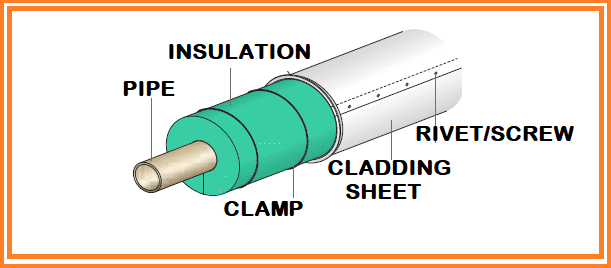
Some Important Point to Consider, While Selecting the Cladding Materials
- As a general rule, We should prefer galvanized steel over aluminum for indoor piping. As it’s mechanical strength, fire resistance, and low surface temperature is higher compared to the aluminum cladding.
- In corrosive environments like outdoor piping aluminized steel, stainless steel, or glass-reinforced polyester is used as cladding.
- If the piping system is under fire risk environment, then it is recommended to use stainless steel cladding.
- The surface temperature of the cladding totally depends upon the MOC (Material of Construction) of the cladding, the shinier the surface the higher the surface temperature of the cladding sheet.
- To ignore the risk of galvanic corrosion, we should use the material that does not get corroded due to their electrochemical potentials.
- For acoustic insulation (it reduces the noise), a noise absorbent material like (lead layer, polyethylene foil) is installed on/inside the insulation.
Note: The above consideration may change from project to project, do not stick to these points only.
Piping Insulation Types
There are mainly four types of insulation-
- Hot Insulation
- Cold Insulation
- Acoustic Insulation
- Personal Protection Insulation
| Insulation Types | Application | Temperature Range | Notation |
|---|---|---|---|
| HOT | When the Piping system is under High Temperature | Above 60° C | H |
| COLD | If the piping system is under Cryogenic Condition | Below 20° C | C |
| Acoustic | If the piping system creates unbearable noise under operating condition | Not fixed, depend upon noise level only | A |
| Personal Protection | When the piping system is under high temperature and within the human reach, it is recommended to use Personal protection insulation to avoid any accident. | Above 60° C or You can say above bearable temperature | PP |
Note: 2. If the piping system temperature is between 20° C – 60 ° C, then there is no insulation requirement.
Pipe Insulation Classes
Class 1 – Heat Conservation
The purpose of class 1 insulation is to reduce heat losses and to maintain temperatures for the efficient operation of the process.
Class 2 – Cold Medium Conservation
The purpose of class 2 insulation is to maintain low temperature and control heat input to the process.
Class 3 – Personnel Protection
The surfaces with operating temperatures below -10 °C or above 70 °C and are restricted to a distance of not more than 2.1 m vertical and 0.8 m horizontal away from walkways and normal working areas shall be guarded by screens. Insulation shall only be used if the guards are not practical.
Class 4 – Frost Proofing
The purpose pf class 4 Insulation or Heat Tracing is to prevent freezing, solidification and condensation.
Class 5 – Fire Proofing
The purpose of class 5 insulation is to reduce the heat input and to control the temperature to 400 °C on piping, vessels and equipment in a hydrocarbon fire situation, and lasting for 30 minutes according to ISO 834. Fire proofing according to any other fire situation shall be specified in each project. Selected fire proofing should be documented, and if necessary it should be fire tested.
Class 6, 7 and 8 – Acoustic Insulation Class
Class 6 – Noise reduction in the area 500-2000 Hz by 10 dB.
Class 7 – Noise reduction in the area 500-2000 Hz by 20 dB.
Class 8 – Noise reduction in the area 500-2000 Hz by 30 dB.
Class 9 – External Condensation and Icing Protection
The purpose of class 9 insulation is to prevent condensation on piping and equipment with operating temperatures below ambient.
Piping Insulation Materials
Piping Insulation materials for classes 1, 2, 3, 4, and 9 shall contain cellular glass. Insulation materials for classes 5, 6, 7, and 8 shall contain cellular glass in combination with mineral wool, mineral fiber, or ceramic fibers. I have mentioned below some of the most commonly used materials-
- Cellular glass – Glass manufactured
- Mineral wool – Includes rock and slag wools
- Glass wool – High-temperature fibrous insulation material
- Flexible elastomeric foams – Flexible, closed-cell, rubber foams
- Rigid foam – Pipe insulation made from rigid Phenolic, PIR, or PUR
- Polyethylene – Mainly used to prevent freezing of water supply pipes
- Aerogel – It has the lowest thermal conductivity
- Stainless steel
- Aluminum alloy
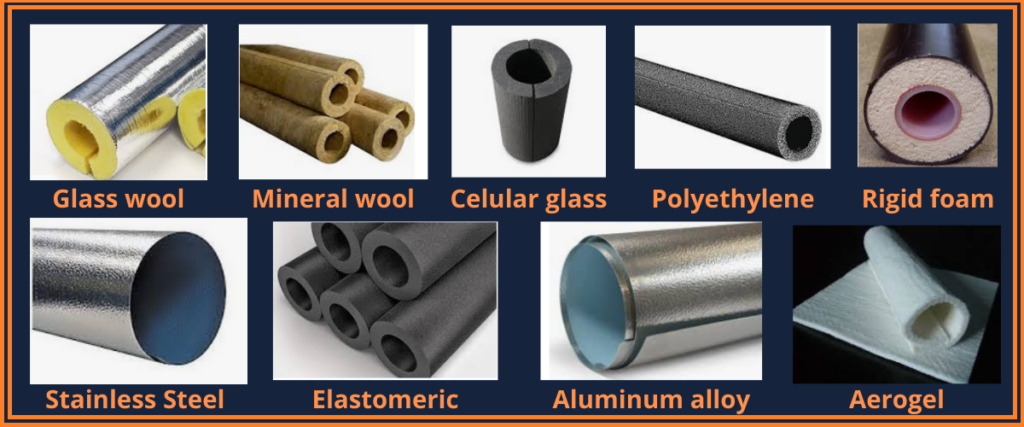
Codes and Standards Related to Insulation
- IS 3677 / IS 3690 – Glass Wool
- IS 8183/ IS 9842 – Rock Wool
- IS 12436 – Polyurethane Foam
- IS 4671 – Expanded Polystyrene
- IS 3346 – Determination of Thermal Conductivity
- IS 737 – Cladding Sheet
- ASTM C1639 – Fabrication of Cellular Glass Pipe and Tubing Insulation
- ASTM C3 – Dimensioning of insulation
- ASTM C177 – Thermal conductivity
- ASTM C165 – For testing mechanical Strength
- ASTM C411 – Testing and Inspection
You may also like
1. A Presentation on Pipe Stress Analysis
2. Checklist For Piping Isometric Drawing
3. Control Station and Control Valve in the Process Piping
4. Piping Line Study: 20 Important Steps to Follow
Reference(s)
www.wermac.org
www.pmmag.com

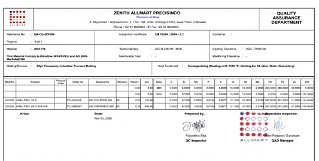
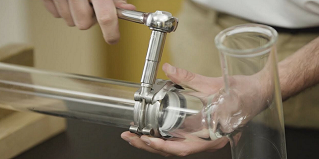
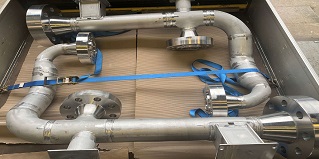
Good knowledge for pipe insulation, I like it’s
Thank you
Very valuable information, it’s not at all blogs that we find this,
Thank you, I was searching for something like that and found it here.
King regards,
Dinesen Hessellund
Nice write up!
Thanks for pointing out that pipe insulation plays an important role in the process and power plant. I would imagine that any industrial company would want to avoid incidents that can affect their operations. I think they should look for a reliable company that can provide pipe insulation services for their organization.
Yes, You are right.
It’s great that you explained that pipe insulation can increase its efficiency. My friend wants to get their pipe insulated. I should advise him to go for it to achieve efficiency.
what is the difference between class 4 and class 9..is both class are related to frosting?